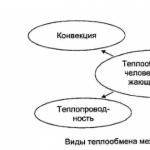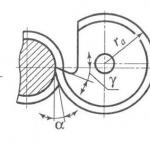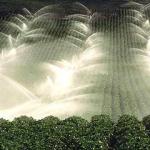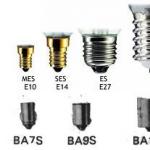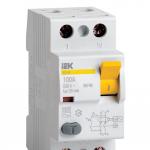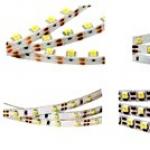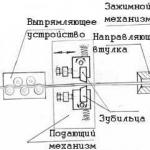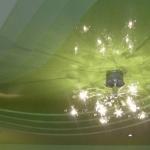White LED
Powerful white LED
There are two types of white LEDs:
- Multi-chip LEDs, more often three-component (RGB-LEDs), incorporating three semiconductor emitters of red, green and blue light, combined in one package.
- Phosphor LEDs created on the basis of an ultraviolet or blue LED, incorporating a layer of a special phosphor, which, as a result of photoluminescence, converts part of the LED radiation into light in a relatively wide spectral band with a maximum in the yellow region (the most common design). The radiation of the LED and the phosphor, mixing, give white light of various shades.
Invention history
The first red semiconductor emitters for industrial use were obtained by N. Holonyak in 1962. In the early 70s, yellow and green LEDs appeared. Light output at the beginning of low-efficiency devices reached the level of one lumen by 1990. In 1993, Suji Nakamura, an engineer at Nichia (Japan), created the first high-brightness blue LED. Almost immediately, RGB LED devices appeared, since blue, red and green colors made it possible to obtain any color, including white. White phosphor LEDs first appeared in 1996. Subsequently, the technology developed rapidly and by 2005 the light output of LEDs reached 100 lm/W or more. LEDs with different shades of glow appeared, the quality of light made it possible to compete with incandescent lamps and with already traditional fluorescent lamps. The use of LED lighting devices in everyday life, in indoor and outdoor lighting has begun.
RGB LEDs
White light can be created by mixing LEDs of different colors. The trichromatic design of red (R), green (G), and blue (B) sources is the most common, although bichromatic, tetrachromatic, and more multicolored variants are also found. A multi-color LED, unlike other RGB semiconductor emitters (lamps, lamps, clusters), has one finished body, most often similar to a single-color LED. The LED chips are placed next to each other and share the same lens and reflector. Because semiconductor chips are finite in size and have their own polar patterns, such LEDs most often have uneven angular color characteristics. In addition, to obtain the correct color ratio, it is often not enough to set the rated current, since the light output of each chip is not known in advance and is subject to changes during operation. To set the desired shades, RGB lamps are sometimes equipped with special control devices.
The spectrum of an RGB LED is determined by the spectrum of its constituent semiconductor emitters and has a pronounced line shape. Such a spectrum is very different from the spectrum of the sun, hence the RGB color rendering index of the LED is low. RGB-LEDs allow you to easily and widely control the color of the glow by changing the current of each LED included in the triad, adjust the color tone of the white light they emit right in the process - up to obtaining individual independent colors.
Multicolor LEDs have a dependence of light output and color on temperature due to various characteristics of the emitting chips that make up the device, which affects a slight change in the color of the glow during operation. The service life of a multi-color LED is determined by the durability of the semiconductor chips, depends on the design, and most often exceeds the service life of phosphor LEDs.
Multicolor LEDs are mainly used for decorative and architectural lighting, in electronic displays and video screens.
Phosphor LEDs

The spectrum of one of the variants of the phosphor LED
The combination of a blue (more often) or ultraviolet (less often) semiconductor emitter and a phosphor converter makes it possible to produce an inexpensive light source with good characteristics. The most common design of such an LED contains a blue gallium nitride semiconductor chipmodified with indium (InGaN) and a phosphor with a reemission maximum in the yellow region - yttrium-aluminum garnet doped with trivalent cerium (YAG). Part of the power of the initial radiation of the chip leaves the LED housing, being scattered in the phosphor layer, the other part is absorbed by the phosphor and re-emitted in the region of lower energy values. The re-emission spectrum covers a wide area from red to green, but the resulting spectrum of such an LED has a pronounced dip in the green-blue-green region.
Depending on the composition of the phosphor, LEDs are produced with different color temperatures (“warm” and “cold”). By combining different types of phosphors, a significant increase in the color rendering index (CRI or R a) is achieved, which makes it possible to speak of the possibility of using LED lighting in critical conditions for color rendering quality.
One way to increase the brightness of phosphor LEDs while maintaining or even reducing their cost is to increase the current through a semiconductor chip without increasing its size - increasing the current density. This method is associated with a simultaneous increase in the requirements for the quality of the chip itself and the quality of the heat sink. As the current density increases, the electric fields in the volume of the active region reduce the light output. When the limiting currents are reached, since sections of the LED chip with different impurity concentrations and different band gaps conduct current in different ways, local overheating of the chip sections occurs, which affects the light output and the life of the LED as a whole. In order to increase the output power while maintaining the quality of the spectral characteristics, thermal conditions, LEDs are produced containing clusters of LED chips in one package.
One of the most discussed topics in polychrome LED technology is their reliability and durability. Unlike many other light sources, an LED changes its light output characteristics (efficiency), radiation patterns, color shade over time, but rarely fails completely. Therefore, to assess the useful life, for example, for lighting, the level of reduction in light output to 70% of the original value (L70) is taken. That is, an LED whose brightness has decreased by 30% during operation is considered to be out of order. For LEDs used in decorative lighting, a 50% dimming level (L50) is used as a lifetime estimate.
The service life of a phosphor LED depends on many parameters. In addition to the manufacturing quality of the LED assembly itself (the method of fastening the chip on the crystal holder, the method of fastening current-carrying conductors, the quality and protective properties of sealing materials), the lifetime mainly depends on the characteristics of the emitting chip itself and on changes in the properties of the phosphor over time (degradation). Moreover, as numerous studies show, temperature is considered the main factor influencing the life of the LED.
Effect of Temperature on LED Lifespan
A semiconductor chip radiates part of the electrical energy in the form of radiation during operation, and part in the form of heat. At the same time, depending on the efficiency of such conversion, the amount of heat is about half for the most efficient radiators or more. The semiconductor material itself has a low thermal conductivity, in addition, the materials and package design have a certain non-ideal thermal conductivity, which leads to the chip heating to high (for a semiconductor structure) temperatures. Modern LEDs operate at chip temperatures in the region of 70-80 degrees. And a further increase in this temperature when using gallium nitride is unacceptable. High temperature leads to an increase in the number of defects in the active layer, leads to increased diffusion, a change in the optical properties of the substrate. All this leads to an increase in the percentage of nonradiative recombination and the absorption of photons by the chip material. An increase in power and durability is achieved by improving both the semiconductor structure itself (reducing local overheating), and by developing the design of the LED assembly, improving the quality of cooling of the active area of the chip. Also, research is being done with other semiconductor materials or substrates.
The phosphor is also exposed to high temperatures. With prolonged exposure to temperature, the re-emitting centers are inhibited and the conversion coefficient, as well as the spectral characteristics of the phosphor, deteriorate. In the first and some modern designs of polychrome LEDs, the phosphor is applied directly to the semiconductor material and the thermal effect is maximized. In addition to measures to reduce the temperature of the emitting chip, manufacturers use various methods to reduce the effect of chip temperature on the phosphor. Isolated phosphor technologies and LED lamp designs, in which the phosphor is physically separated from the emitter, can increase the life of the light source.
The LED housing, which is made of optically transparent silicone plastic or epoxy resin, is subject to aging due to temperature and begins to fade and turn yellow over time, absorbing some of the energy emitted by the LED. Reflective surfaces also deteriorate when heated - they interact with other elements of the case and are subject to corrosion. All these factors together lead to the fact that the brightness and quality of the emitted light gradually decreases. However, this process can be successfully slowed down, providing efficient heat removal.
Construction of phosphor LEDs

Diagram of one of the designs of a white LED. MPCB is a high thermal conductivity printed circuit board.
A modern phosphor LED is a complex device that combines many original and unique technical solutions. The LED has several main elements, each of which performs an important, often more than one function:
All elements of the LED design experience thermal loads and must be selected taking into account the degree of their thermal expansion. And an important condition for a good design is the manufacturability and low cost of assembling an LED device and mounting it in a luminaire.
Brightness and quality of light
The most important parameter is not even the brightness of the LED, but its light output, that is, the light output from each watt of electrical energy consumed by the LED. The luminous efficiency of modern LEDs reaches 150-170 lm/W. The theoretical limit of the technology is estimated at 260-300 lm/W. When evaluating, it must be taken into account that the efficiency of a luminaire based on LEDs is significantly lower due to the efficiency of the power supply, the optical properties of the diffuser, reflector and other structural elements. In addition, manufacturers often indicate the initial efficiency of the radiator at normal temperature. While the temperature of the chip during operation is much higher. This leads to the fact that the real efficiency of the emitter is lower by 5 - 7%, and the lamp is often twice as low.
The second equally important parameter is the quality of the light produced by the LED. There are three parameters for evaluating color quality:
Phosphor LED based on ultraviolet emitter
In addition to the combination of a blue LED and YAG, which has already become common, a design based on an ultraviolet LED is also being developed. A semiconductor material capable of emitting in the near ultraviolet region is coated with several layers of a phosphor based on europium and zinc sulfide activated with copper and aluminum. Such a mixture of phosphors gives re-emission maxima in the green, blue and red regions of the spectrum. The resulting white light has very good quality characteristics, but the conversion efficiency is still low.
Advantages and disadvantages of phosphor LEDs
Given the high cost of LED lighting sources compared to traditional lamps, there are good reasons to use such devices:
- The main advantage of white LEDs is high efficiency. Low specific energy consumption allows their use in long-term autonomous and emergency lighting sources.
- High reliability and long service life allow us to talk about possible savings on lamp replacement. In addition, the use of LED light sources in hard-to-reach places and outdoor conditions reduces maintenance costs. Combined with high efficiency, there are significant cost savings when using LED lighting in some applications.
- Small weight and size of devices. LEDs are small in size and suitable for use in hard-to-reach places and small-sized portable devices.
- The absence of ultraviolet and infrared radiation in the spectrum allows the use of LED lighting without harm to humans and for special purposes (for example, to illuminate rare books or other objects exposed to light).
- Excellent operation at negative temperatures without a decrease, and often with an improvement in parameters. Most types of LEDs show better efficiency and durability at lower temperatures, however, power supplies, controls, and design elements can have the opposite relationship.
- LEDs are inertialess light sources, they do not require time to warm up or turn off, like fluorescent lamps, and the number of on and off cycles does not adversely affect their reliability.
- Good mechanical strength allows the use of LEDs in harsh environments.
- Ease of power regulation by both duty cycle and supply current regulation without compromising efficiency and reliability parameters.
- Safe to use, no risk of electric shock due to low supply voltage.
- Low fire hazard, the ability to use in explosive and fire hazard due to the absence of incandescent elements.
- Moisture resistance, resistance to aggressive environments.
- Chemical neutrality, no harmful emissions and no special requirements for disposal procedures.
But there are also disadvantages:
Lighting LEDs also have features inherent in all semiconductor emitters, taking into account which, you can find the most successful application, such as radiation directivity. The LED shines only in one direction without the use of additional reflectors and diffusers. LED luminaires are best suited for local and directional lighting.
Prospects for the development of white LED technology
Technologies for the manufacture of white LEDs suitable for lighting purposes are under active development. Research in this area is stimulated by increased public interest. The promise of significant energy savings is attracting investment in process research, technology development and the search for new materials. Judging by the publications of manufacturers of LEDs and related materials, specialists in the field of semiconductors and lighting engineering, it is possible to identify the development paths in this area:
see also
Notes
- , p. 19-20
- Cree MC-E LEDs containing red, green, blue, and white emitters. LED professional. archived
- Vishay's VLMx51 LEDs containing red, orange, yellow and white emitters. LED professional. Archived from the original on November 23, 2012. Retrieved November 10, 2012.
- Cree XB-D and XM-L Multicolor LEDs. LED professional. Archived from the original on November 23, 2012. Retrieved November 10, 2012.
- Cree XP-C LEDs containing six monochromatic emitters. LED professional. Archived from the original on November 23, 2012. Retrieved November 10, 2012.
- Nikiforov S."S-class" of semiconductor lighting technology // Components and technologies: magazine. - 2009. - No. 6. - S. 88-91.
- Truson P. Halvardson E. Benefits of RGB LEDs for Lighting // Components and technologies: magazine. - 2007. - No. 2.
- , p. 404
- Nikiforov S. Temperature in the life and work of LEDs // Components and technologies: magazine. - 2005. - No. 9.
- LEDs for interior and architectural lighting (eng.). LED professional. Archived from the original on November 23, 2012. Retrieved November 10, 2012.
- Xiang Ling Oon LED solutions for architectural lighting systems // : magazine. - 2010. - No. 5. - S. 18-20.
- RGB LEDs for use in electronic scoreboards. LED professional. Archived from the original on November 23, 2012. Retrieved November 10, 2012.
- Turkin A. Gallium nitride as one of the promising materials in modern optoelectronics // Components and technologies: magazine. - 2011. - No. 5.
- High CRI LEDs. LED professional. Archived from the original on November 23, 2012. Retrieved November 10, 2012.
- Cree's EasyWhite Technology. LEDs Magazine. Archived from the original on November 23, 2012. Retrieved November 10, 2012.
- Nikiforov S., Arkhipov A. Features of determining the quantum yield of LEDs based on AlGaInN and AlGaInP at different current densities through the emitting crystal // Components and technologies: magazine. - 2008. - No. 1.
- Nikiforov S. Electrons can now be seen: LEDs make electric current very visible // Components and technologies: magazine. - 2006. - No. 3.
- LEDs with a matrix arrangement of a large number of semiconductor chips (eng.). LED professional. Archived from the original on November 23, 2012. Retrieved November 10, 2012.
- White LED Lifespan Archived from the original on November 23, 2012. Retrieved November 10, 2012.
- Types of LED Defects and Analysis Methods. LED professional. Archived from the original on November 23, 2012. Retrieved November 10, 2012.
- , p. 61, 77-79
- SemiLEDs LEDs. LED professional. Archived from the original on November 23, 2012. Retrieved November 10, 2012.
- GaN-on-Si Silicon-Based LED Research Program. LED professional. Retrieved November 10, 2012.
- Cree Isolated Phosphor Technology. LED professional. Archived from the original on November 23, 2012. Retrieved November 10, 2012.
- Turkin A. Semiconductor LEDs: history, facts, prospects // Semiconductor lighting technology: magazine. - 2011. - No. 5. - S. 28-33.
- Ivanov A. V., Fedorov A. V., Semyonov S. M. Energy-saving lamps based on high-brightness LEDs // Energy supply and energy saving - a regional aspect: XII All-Russian meeting: materials of reports. - Tomsk: SPB Graphics, 2011. - S. 74-77.
- , p. 424
- White LEDs with high light output for lighting needs. Phys.Org™. Archived from the original on November 23, 2012. Retrieved November 10, 2012.
- Fundamentals of LED Lighting. U.S. Department of Energy. Archived from the original on November 23, 2012. Retrieved November 10, 2012.
- Sharakshane A. Scales for assessing the quality of the spectral composition of light - CRI and CQS // Semiconductor lighting technology: magazine. - 2011. - No. 4.
- Ultraviolet LEDs SemiLED with a wavelength of 390-420 nm. (English) . LED professional. Archived from the original on November 23, 2012. Retrieved November 10, 2012.
- , p. 4-5
- Nuventix Active Cooling Systems. LED professional. Archived from the original on November 23, 2012. Retrieved November 10, 2012.
- N.P. Soshchin Modern photoluminophores for efficient solid-state lighting devices. Conference materials. (Russian) (February 1, 2010). archived
- O.E.Dudukalo, V.A.Vorobiev(Russian) (May 31, 2011). Archived from the original on October 27, 2012.
- Tests for accelerated thermal degradation of phosphors. LED professional. Archived from the original on November 23, 2012. Retrieved November 10, 2012.
- Research and Markets Releases New 2012 Report on LED Phosphor Materials. LED professional. Archived from the original on December 10, 2012. Retrieved November 30, 2012.
- Intematix introduced a set of phosphors for high-quality color reproduction (eng.) . LED professional. Archived from the original on November 23, 2012. Retrieved November 10, 2012.
- Lumi-tech proposes SSE phosphor for white LEDs. LED professional. Archived from the original on November 23, 2012. Retrieved November 10, 2012.
- Red Phosphorus by Intematix. LED professional. Archived from the original on November 23, 2012. Retrieved November 10, 2012.
- Quantum Dot LEDs. LED professional. Archived from the original on November 23, 2012. Retrieved November 10, 2012.
- Osram's 609 nm red all-diode prototype with 61% efficiency. LED professional. Archived from the original on November 23, 2012. Retrieved November 10, 2012.
- Transition to the GaN-on-Si structure (English) . LED professional. Archived from the original on November 23, 2012. Retrieved November 10, 2012.
- Tim Whitaker Joint venture to make ZnSe white LEDs (December 6, 2002). Archived from the original on October 27, 2012. Retrieved November 10, 2012.
- , p. 426
Literature
- Schubert F.E. LEDs. - M .: Fizmatlit, 2008. - 496 p. - ISBN 978-5-9221-0851-5
- Weinert D. LED Lighting: A Handbook. - Philips, 2010. - 156 p. - ISBN 978-0-615-36061-4
Links
- US Department of Energy LED Lighting website
- led professional. Scientific and technical journal about LEDs and LED lighting, Austria
- LEDs Magazine. Scientific and technical journal about LEDs and LED lighting. USA
- Semiconductor lighting technology. Russian magazine about LEDs and LED lighting
| incandescent | Incandescent lamp Halogen lamp |
|---|---|
| Fluorescent | |
LED (Lighting Emission Diode) - LEDs with intense light emission are well known to everyone. About 10 years ago (here in Russia) they made a "quiet revolution in lighting", especially where mobility, low specific energy consumption, reliability and long service life are needed. It seemed that the ideal source of light, which was longed for, led and just tourists, as well as hunters and fishermen, speleologists and climbers are already "here and now." And it is enough to reach out, having accumulated a bit of dead raccoons, and there will be "peace on earth, goodwill in men." Now, we can say that these 10 years have not been in vain and the LED reality turned out to be interesting, diverse and provides new opportunities that had not even occurred to us before.

Rice. 2 Design of Luxeon LED by Lumileds lighting.* (“Description and working principle of LED lamps” Energy Saving Group of Companies )

Rice. 3 Blue LED with monochromatic emission. . ("LED - technology, principle of operation. Pros and cons of LED. "
PRINCIPLE OF OPERATION .
An LED is primarily a diode. That is, a kind of tricky pebble with a p-n junction inside. In other words, the contact of two semiconductors with different types of conductivity. Which, under certain conditions, emits light in the process of recombination (mutual constructive suicide) of electrons and holes.
Usually, the greater the current through the LED, the more electrons and holes enter the recombination zone per unit time, and more light is emitted at the output. But the current cannot be greatly increased - due to the internal resistance of the semiconductor and the p-n junction, the LED can overheat, which leads to its accelerated aging or failure.
To obtain a significant luminous flux, create multilayer semiconductor structures - heterostructures. For the development of semiconductor heterostructures for high-speed optoelectronics, Zhores Alferov, a Russian physicist, received the Nobel Prize in 2000.
TWO WORDS FOR STORY.
The first red semiconductor emitters for industrial use were obtained in 1962. In the 60s and 70s, LEDs based on phosphide and gallium arsenide were created, emitting in the yellow-green, yellow and red regions of the spectrum. They were used in indicator lights and alarm systems. In 1993, Nichia (Japan) created the first high-brightness blue LED. Almost immediately, RGB LED devices appeared, since blue, red and green colors made it possible to obtain any color, including white. White phosphor LEDs first appeared in 1996. Subsequently, the technology developed rapidly and by 2005 the light output of LEDs reached over 100 lm/W.
WHITE LIGHT.
An ordinary colored LED emits in a narrow spectrum of light waves (monochromatic radiation). This is good for alarm devices. And for lighting, white LEDs are needed and different technologies are used ..
For example, mixing colors using RGB technology. Red, blue and green LEDs are densely placed on one matrix, the radiation of which is mixed using an optical system, such as a lens. The result is white light.

Rice. 4 RGB LED emission spectrum. ("Wikipedia")
Or, let's say, a phosphor is used, more precisely, several phosphors are applied to the LED and, as a result of mixing colors, white or close to white light is obtained. White LEDs with phosphors are cheaper than RGB matrices, which made it possible to use them for lighting.

Rice. 5 The emission spectrum of a white LED with a phosphor. * ("Wikipedia")

Rice. 6 White LED with phosphor. Diagram of one of the designs of a white LED.
MRCB - printed circuit board with high thermal conductivity. * ("Wikipedia")
The current-voltage characteristic of LEDs in the forward direction is non-linear and the current begins to flow, from a certain threshold voltage. In the basic LED modes, the current is exponentially dependent on voltage, and small changes in voltage lead to large changes in current. And since the light output is directly proportional to the current, the brightness of the LED is also unstable. Therefore, the current has to be stabilized. The brightness of the LEDs can, for example, be adjusted using a pulse-width modulation (PWM) method, which requires an electronic device that supplies high-frequency pulsed signals to the LED. Unlike incandescent lamps, the color temperature of LEDs changes very little when dimming. .
Advantages and disadvantages of phosphor LEDs.
In an LED, unlike an incandescent or fluorescent lamp, the electrical current is converted directly into light radiation and the losses are therefore relatively small.
- The main advantage of white LEDs is high efficiency, low specific power consumption and high light output - 160-170 Lumen/Watt.
- High reliability and long service life.
- The light weight and dimensions of the LEDs allow them to be used in small-sized portable lamps.
- The absence of ultraviolet and infrared radiation in the spectrum allows the use of LED lighting without harmful consequences, since ultraviolet, especially in the presence of ozone, strongly affects organic matter, and infrared radiation can cause burns.
- The specific power density indicator, which characterizes the density of the luminous flux, for a standard fluorescent lamp is 0.1-0.2 W / cm², and for a modern white LED about 50 W / cm².
- Operation at negative temperatures without reduction, and often with improvement of parameters.
- LEDs are inertialess light sources, they do not require time to warm up or turn off, like fluorescent lamps, and the number of on and off cycles does not affect their reliability.
- The LED is mechanically strong and exceptionally reliable.
- Ease of brightness control.
- The LED is a low-voltage electrical appliance, and therefore safe.
- Low fire hazard, the ability to use in explosive environments.
- Moisture resistance, resistance to aggressive environments.
But there are also minor drawbacks:
- White LEDs are more expensive and more difficult to manufacture than incandescent lamps, although their price is gradually decreasing.
- Poor color reproduction quality, which, however, is gradually improving.
- Powerful LEDs require a good cooling system.
- Rapid deterioration of performance and even failure at elevated ambient temperatures of more than 60 - 80 ° C.
- Phosphors also do not like high temperatures, because. the conversion coefficient and the spectral characteristics of the phosphor deteriorate.
- The housing of the LED is made of optically transparent silicone plastic or epoxy resin, which ages and dims and turns yellow under the influence of temperature, absorbing part of the light flux.
- A modern, powerful, ultra-bright LED can blind and damage a person's vision.
- Contacts are subject to corrosion failures. Reflectors (usually made of plastic coated with a thin layer of aluminum), at elevated temperatures, deteriorate over time, and the brightness and quality of the emitted light gradually deteriorate.
REAL LIFETIME OF WHITE LEDS.

Rice. 7 Decrease in light output during operation and failure behavior of incandescent lamps (INC), fluorescent lamps (FL), high intensity discharge lamps (HID) and LED lamps (not to scale, type curves shown).
Magazine "Electronics Time", Article "Determining the life of LEDs"
Written by Eric RichmanEricRichman), Senior Researcher,PacificnorthwestNationalLaboratories (PNNL)
We have known about 100,000 hours of LED service for many years. How about really?
“In the early days of LEDs, the most common run time was 100,000 hours. At the same time, no one could explain where this magic number came from. Most likely, it was dictated by the market, not science. Philips Lumileds was the first manufacturer of LEDs to indicate the duration of operation, based on real technical parameters, with their brainchild, the Luxeon LED. The durability of the first Luxeon devices, with a given drive current of 350 mA and a junction temperature of 90 degrees Celsius, was estimated at 50,000 hours. This means that after 50,000 hours of operation of the LED under given conditions, its luminous flux will decrease to 70% of the original.
Article "Uncharted waters: determining the durability of LED lamps", Electronics Time magazine, Timur Nabiev.
Currently, there is no standard defining for LEDs what exactly "lifetime" is. There are also no standards that quantify the color change of an LED over time. It is not defined how the LED should work after this period. Some leading companies have been forced to determine criteria for service life themselves. For example, two threshold values of the luminous flux were chosen: - 30% and 50%, upon reaching which the LED is considered to be out of order. And these values depend on the perception of the emitted light by the human eye.
1) - 30% reduction in luminous flux of reflected LED light. That is, when the LED light illuminates the road, surrounding objects, etc.
2) - 50% reduction in luminous flux when direct light is used, e.g. in traffic lights, traffic signs, car parking lights....
And other first-tier companies choose only one threshold - 50%.
Moreover, the degradation of LEDs and LED lamps occurs at all levels, starting with the p-n junction and ending with the transparent front plastic lens of the lamp housing. Moreover, low-power signal and indicator LEDs can serve for decades. And super-bright modern LEDs, which often work in a stressful mode, both in terms of current and temperature, and lose their brightness much faster. Thus, the real service life of high-quality modern LEDs is from several months to five to six years in continuous operation. For example, Petzl claims a lifespan of at least 5,000 hours for its LED lights. By the way, leading companies often claim a shorter service life of their devices than that of “super-duper-budget”, often Asian manufacturers, who simply boost the current value and achieve a bright glow. When buying flashlights, all the characteristics of the LEDs correspond to the passport ones, in which they always write about the magical 100,000 hours. But the real service life of such LEDs may not exceed 1000 ... 1500 hours, and during this time the luminous flux decreases at least 2 times.
BATTERIES AND ACCUMULATORS.
During operation, batteries and accumulators are discharged, the supply voltage decreases, the brightness of the LEDs and the effective luminous flux gradually decrease.

Brightness reduction curve for natural battery discharge.

Brightness with electronic adjustment. Illumination of 0.25 lux is measured at a distance of 2 meters from the lamp. (This illumination gives the moon during the full moon).
To improve the effective light output, electronic adjustment (stabilization) of the supply voltage is used. The current strength is controlled by a special microcircuit, which ensures stable brightness throughout the entire operation time. The idea was first developed by Petzl. Thanks to the electronic circuit, the lights have stable characteristics during the entire time of operation, and then go into emergency mode (0.25 lux). A brightness of 0.25 lux is the illumination that a full moon gives high above the horizon on a clear day.
Optimum power supplies.
1. For LED flashlights today, these are of course alkaline or lithium (lithium-ion) disposable batteries. Lithium batteries are lightweight, have a high capacity and perform well at low temperatures. These are, for example, Li-MnO2 batteries CR123 or CR2 with a voltage of 3V or Li-FeS2 (lithium iron disulfide) batteries with a voltage of 1.5V, but not all LED lights are compatible with lithium batteries - you need to specify in the instructions.
2. Batteries.
|
Characteristics |
Nickel-cadmium |
Nickel metal hydride |
Lithium- |
|
Rated voltage, V |
|||
|
Typical capacity, Ah |
|||
|
Specific energy: |
30 - 60 |
40 - 80 |
100 - 180 |
|
Maximum constant discharge current, up to |
5 (10) WITH |
3 WITH |
2 WITH |
|
Charge mode |
Standard: current 0.1 WITH 16 h |
Standard: current 0.1 WITH 16 h |
Current charge 0.1- 1 WITH |
|
Capacitance return coefficient (Сdischarge/Сcharge) |
|||
|
Operating temperature range, ºС |
|||
|
Self-discharge (in %): |
4 - 5 |
Current 1C means a current numerically equal to the rated capacity.
* From the article: A.A. Taganova "LITHIUM CURRENT SOURCES FOR PORTABLE ELECTRONIC EQUIPMENT"
Nickel-cadmium
(NiCd) have a small weight and dimensions, Poor environmental friendliness - cadmium is a terribly unhealthy metal. Explosive with a durable and sealed housing, having microvalves for automatic gas discharge, but at the same time, sufficiently high reliability and high charging-discharging currents. They are often used in on-board equipment and for devices that consume high power, such as diving lights. The only type of battery that can be stored discharged, unlike Nickel Metal Hydride (Ni-MH) batteries, which must be stored fully charged and Lithium-Ion (Li-ion) batteries, which must be stored at 40% charge from battery capacity
Nickel metal hydride
(Ni-MH) were developed to replace Nickel Cadmium (NiCd). NiMH batteries are practically free from the “memory effect” and full discharge is not often required. Environmentally friendly. The most favorable mode of operation: charge with a small current, 0.1 rated capacity, charge time - 15-16 hours (manufacturer's recommendation). Batteries are recommended to be stored fully charged in the refrigerator, but not below 0 C?. Provide a 40-50% advantage in specific energy consumption compared to the former favorite - NiCd. They have significant potential for increasing energy density. Environmentally friendly - contain only mild recyclable toxins. Inexpensive. Available in a wide range of sizes, options and performance.
DIMENSIONS AND FLASHERS.
12) TL-LD1000 Cat Eye
13) RAPID 1 (TL-LD611-F) CatEye
European safety practice involves the use of not only rear but also front marker lights.
Rapid 1 front (white) and rear (red) lights, with USB rechargeable battery and charge level indicator. The high power of the flashlight is achieved by using SMD-LED and OptiCube ™ technology. The flickering CatEye Rapid 1 catches the attention of motorists and passers-by.
4 operating modes provide an optimal choice of parameters, both at night and during the day. CatEye Rapid 1 comes with the SP-12 Flextight™ Low Profile Bracket, which is compatible with all new RM-1.
Working time: 5 hours (continuous mode)
25 hours (fast and pulse modes)
40 hours (flashing mode)
Lighting memory mode (the last mode you turned on)
Li-ion USB battery - rechargeable
Weight about 41 gr. with mount and battery
Clip on clothes.
14) SOLAR (SL-LD210) CatEye

The cyclist must be visible not only from the back, but also by the oncoming traffic, not only at night, but also during the day - with the side lamp on.
One 5mm LED turns on automatically in flashing mode when driving in the dark. The built-in solar panel charges within 2 hours in good weather conditions and provides up to 5 hours of operation. Available in front and rear mounting models and comes with the new Flextight™ Bracket. Weight 44 gr. with bracket and battery
DYNAMO - LANTERNS (BUGS).
15) blueBIRD


3 LEDs, brightness 6 Lm, 3 modes, two constant (1LED and 3LED), one flashing (3LED), operation after recharging: - about 40 minutes (3LED); - about 90 minutes (1LED), weight with handlebar mount 115g.
Impression:
Well, a very successful flashlight, IMHO, both as a size on a bicycle, and for lighting in “manual mode” in a tent, at a halt and in general. In civilized urban conditions, when there is general lighting and with good eyesight, it can even be the main lamp, especially if the road is known. The dynamka spins easily, does not make much noise, the battery charges quickly. Shines a good white light. OK!
16) Charger Energenie EG-PC-005 for mobile phones with a manual drive and a flashlight. Installed on a bike.


Energy is generated by a dynamo with a crank. Turning the handle for three minutes charges the mobile phone for at least 8 minutes of talk time. Rotating the handle for 10 minutes provides a bright flashlight for at least 50 minutes.
Specifications
- Outgoing voltage - 4.0-5.5V
- Outgoing current up to 400 mA
- Built-in 80 mAH Ni-MH rechargeable battery allows at least 500 full recharges
- 2 flashlights:
-head: LED, with a maximum charge illuminates up to 10 meters.
-rear: red LED. - Two modes: constant glow (3LED), - strobe (3LED)
- Net weight 0.2 kg
Contents of delivery
- Energenie EG-PC-005 manual mobile phone charger with bike mount and front flashlight
- rear flashlight with 1.2m cable
- cable for Nokia phones
- 6 adapters for other phones
Impression:
A good size, suitable for lighting in a tent and for all household needs. LEDs are not the best - with a clear bluish tint, which is not good. Unfortunately, the battery has some difficulty coping with a double load (3LED) in front and a red envelope in the back - and “sit down” quickly enough. I had to turn off and throw out the red tail light and, IMHO, it got better (longer). The speaker lever turns easily, there is not much noise, its own battery charges without problems. I had to charge in field conditions and a mobile phone and an e-book. With some perseverance and patience, this can be done, but you have to work hard. When the flashlight is working on an external load, the force on the lever will increase significantly and you have to sweat a little. But the overall assessment of this device is a useful thing.
17) Charger Energenie EG-SC-001 for mobile phones with a battery charged from light and from the mains and with a built-in LED flashlight.

The presence of a USB connector allows you to quickly charge the built-in battery equipped with protection against overcharging, deep discharge, overload and short circuit. In the event of a low battery, an alert system is triggered. Has a built-in LED flashlight.
Charges the following mobile phones and is equipped with the following connectors: Nokia 6101 and 8210 series, Samsung A288 series, Mini USB 5pin, Sony Ericsson K750 series, Micro-USB.
Solar cells Energy EG-SC-001 allows you to charge mobile devices on a hike, of course, in sunny weather.
Specifications
- outgoing voltage - 5.4V
- outgoing current up to 1400 mA
- built-in Li-ion rechargeable battery 2000 mAH allows at least 500 full recharges
- built-in USB connector 5-6V
- bright led flashlight
- dimensions: 116*49*26mm
- weight 130 g
Contents of delivery
- Charger
- AC220V-DC5V USB Power Adapter A black
- 5 adapters for charging mobile phones
- Connecting USB cable.
They are made on the basis of a blue crystal (InGaN) and a yellow phosphor, which allows you to convert blue radiation into white. With this technology, a greater light output is obtained and it is also economically beneficial. The term "phosphor" itself comes from the Latin lumen - light and the Greek phoros - carrier. Under the action of various kinds of excitations, this substance begins to glow. To create white LEDs, a yellow phosphor is used - this is a modified yttrium-aluminum garnet doped with trivalent cerium. Thus, a luminescence spectrum with a maximum wavelength of 530..560 nm is achieved. To get an LED with cold light, Gallium additives are added to the phosphor, and Gadolinium additives with dark light. In turn, global manufacturers of lighting LEDs use phosphors with the following parameters in their production:
| Manufacturer | Lp 1 , nm | Ld 2 , nm | CCT 3 , K |
| Philips Lumileds Lighting Company | ~ 550 | no data | 4500..10000 |
| Cree Inc. | 540..550 | 575..580 | 5000..10000 |
| OSRAM Opto Semiconductors | no data | no data | 4700..6500 |
| COTCO International Ltd. | no data | 570..575 | 4700..6500 |
| Nichia Corp. | ~ 550 | ~ 575 | > 4500 |
| Toyoda Gosei Co., Ltd. | no data | ~ 575 | > 4500 |
| Gelcore LLC | no data | no data | 6500 |
| Seoul Semiconductors | ~ 560 | no data | 6500 |
1 The wavelength of the maximum emission of the phosphor
2 Dominant wavelength of phosphor emission
3 Correlated LED emission color temperature
And in this table you can find out the conversion coefficient of the phosphor by the luminous flux:
Let's analyze the current value of 350 mA as an example. At this value, the luminous flux from the original blue light crystal is 11.5 lm, and with a phosphor based on the same crystal it will be 3 times more (about 34.5 lm). In practice, it turns out that in various versions of white lighting LEDs with a phosphor, the ratio of the resulting white luminous flux and the original blue can reach up to 5, and as a rule, in most LEDs of well-known companies it has a value of at least 4, which indicates the quality of the phosphor and the degree of compliance its properties to the characteristics of the original blue crystal.
But also when using a phosphor, there is a loss of optical power when going from blue to white light. Losses can reach up to 25% at different current densities. This may be due to losses directly during the re-emission of the phosphor, and with a change in the spectral composition of the radiation of the blue crystal with a change in current.
Phosphor degradation in white LEDs
The destruction (degradation) of the phosphor is caused by the operation of the LED with an incorrect or violation of the heat removal process. Such an impact on the phosphor can only lead to a decrease in the brightness of the LED, as well as to a change in the shade of its glow. A sign of strong degradation of the phosphor is a clearly visible blue tint of the glow, because its spectrum begins to dominate the own radiation of the LED crystal.
Now, probably, only the deaf have not heard about LED lamps and super-bright LEDs. Among radio amateurs, a super-bright LED has long been the object of close study and the main element of home-made innovative devices. Yes, this is not surprising, super-bright LEDs are interesting primarily for their efficiency and good light output characteristics. LEDs have good mechanical strength, not be afraid of vibration and shaking. No wonder high-power LEDs are increasingly used in the automotive industry.
Another important positive quality of LEDs can be considered that they begin to emit instantly after power is applied. Fluorescent lamps, for example, are inferior to LEDs in this regard. For durable operation of a fluorescent lamp, a hot start is recommended, when the filaments are preheated. The lamp turns on after a few seconds.
In the early 1990s, Nichia introduced the world's first blue and white LED. Since then, a technological race has begun in the production of super-bright high-power LEDs.
By itself, an LED cannot emit white light, since white light is the sum of all colors. Light emitting diode emits light of a strictly defined wavelength. The color of the LED emission depends on the width of the energy band gap of the transition, where the recombination of electrons and holes occurs.
The energy band gap, in turn, depends on the material of the semiconductor. To produce white light on a crystal blue LED a layer of phosphor is applied, which, under the action of blue radiation, emits yellow and red light. Mixing blue, yellow and red produces white light.
It is one of several widespread white light technologies using light emitting diodes.

The supply voltage of ultra-bright white LEDs, as a rule, lies between 2,8 before 3,9 volt. The exact characteristics of the LED can be found in the description (datasheet).
Powerful, ultra-bright white LEDs are available, but are still expensive compared to red and green indicator LEDs, so care must be taken when using them in lighting applications. high-quality LED power supply.
Despite the fact that the resource of LEDs is quite large, any light emitting semiconductor Very sensitive to overcurrent. As a result of overloads, the LED can remain operational, but its light output will be significantly less. In some cases, a partially working LED can cause failure of the rest of the LEDs included with it.
To exclude overloading of LEDs, and, consequently, their failure, apply power drivers on specialized microcircuits. The power driver is nothing more than a stabilized current source. To adjust the brightness of the LEDs, it is recommended to use pulse modulation.
It is possible that in the near future manufacturers of high-power LEDs will embed a current stabilizer chip directly into the design of a high-power LED, similar to flashing LEDs ( blinking led ), which have a built-in pulse generator chip.
The LED can work for decades, but on condition that the light-emitting crystal does not get very hot due to the flow of current. In modern high-power LEDs, the supply current can reach more than 1000 mA(1 Ampere!) at supply voltage from 2,5 before 3,6 – 4 volt. Such parameters have, for example, powerful LEDs Lumileds . To remove excess heat in such LEDs, an aluminum radiator is used, which is structurally integrated with the LED crystal. Manufacturers of high-power white LEDs also recommend installing them on additional heatsinks. The conclusion is obvious - if you want a long-term operation of the LED - ensure good heat dissipation.
When mounting high-power LEDs, it must be remembered that the heat-conducting base of the LED is not electrically neutral. In this regard, it is necessary to ensure the electrical isolation of the bases of the LEDs when mounted on a common radiator.
Since the typical supply voltage of ultra-bright LEDs is 3,6 volt, then such LEDs can be easily used for LED flashlights in conjunction with rechargeable batteries of the format AA. To power the LED, you need 3 rechargeable batteries connected in series with a voltage of 1,2 volt. The total voltage will be just the required 3,6 volt. In this case, no voltage converters are needed.
The still high price of high-power LEDs is associated with the complexity of manufacturing a high-power LED. The cost of modern technological installations, which produce high-power LED crystals using epitaxial technology, is 1.5 - 2 million dollars!
Structurally, a powerful LED is a rather complex device.
The figure shows the device of a super-bright Luxeon III LED from Lumileds, with a power of 5 watts .

As can be seen from the figure, modern ultra-bright LED is a complex device that requires many technological steps in the manufacture.
At present, high power LED manufacturers are trying different LED technologies using different materials and components. All this is aimed at reducing the cost of LEDs and ensuring the required quality of the product.
It should be noted that a powerful LED, manufactured in violation of the technological process and using low-quality materials, loses its calculated light output after some time of operation. As a rule, such LEDs are cheaper than analogues. Cheap LEDs during the first 4000 hours of operation lose their brightness on 35% . This is due to the fact that the epoxy material of the LED bulb turns yellow, and the emissivity of the blue LED chip and the phosphor layer applied to it also decreases. For quality LEDs 50 000 hours of operation, brightness decreases by no more than 20% .
White LED
Unlike traditional incandescent and white light fluorescent lamps, LEDs generate light in a very narrow range of the spectrum, i.e. give an almost monochrome glow. That is why LEDs have long been used in control panels and garlands, and today they are especially effectively used in lighting installations that emit a certain primary color, for example, in traffic lights, pointers, signal lights.
The principle of the white LED
The principle of the white LED device is not very complicated, the implementation technology is complicated. In order for the LED to emit white light, one has to resort to additional technical elements and technical solutions. The main ways to get a white glow in LEDs are:
applying a layer of phosphor, on blue crystals;
applying several layers of phosphor to crystals that emit light close in color to ultraviolet;
RGB systems, in which by mixing the light of many monochrome red, green and blue diodes, a white glow is achieved.
In the first case, most often, blue LED crystals are used, which are coated with a phosphor, yellow phosphorus. Phosphorus absorbs some blue light and emits yellow light. When the remaining unabsorbed blue light is mixed with yellow, a light close to white is obtained.
The second method is a recently developed technology for obtaining solid-state white light sources based on a combination of a diode emitting a glow close to ultraviolet in color and several layers of a phosphor phosphor of various compositions.
In the latter case, white light is obtained in the classical way by mixing the three basic colors (red, green and blue). White light quality is improved by adding yellow LEDs to the RGB configuration to cover the yellow part of the spectrum.
Advantages and disadvantages of former LEDs
Each of these methods has its positive and negative sides. Thus, for white phosphor LEDs, manufactured according to the principle of a combination of blue crystals with a phosphor phosphor, a rather low color rendering index, a tendency to generate white light in cold tones, a non-uniform luminescence shade at a sufficiently high luminous flux and a relatively low cost are characteristic.
White phosphor LEDs based on a combination of near-ultraviolet diodes and multi-colored phosphors, have excellent color rendering index, can generate white light with warmer shades and are more uniform in luminescence shades from diode to diode. However, they consume more electricity and are not as bright as the first ones.
In turn, RGB-LEDs allow you to create light-dynamic effects in lighting installations with a change in the color of the glow and various tones of the white glow and can potentially provide a very high color rendering index. At the same time, LEDs of individual colors respond differently to the amount of operating current, their ambient temperature and dimming, and therefore RGB LEDs require quite complex and expensive control systems to achieve stable operation.
In order for luminaires based on white LEDs to give better light, i.e. a more complete spectrum, in the design of lamps they use



